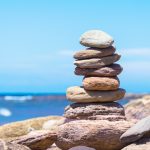Ever felt completely connected to the world around you – whether you’re watching the sunset on a beautiful beach, playing with your children in the park, or simply relishing in the glow of a particularly inspiring yoga class? The sensation of spine-tingling energy travelling through the whole body, and of deep connection to yourself and others, this feeling of interconnectedness awakes us to our true sense of being, and the power that lies within us.
Power is a funny word. We think of corporations as having too much power, or of people in war-torn countries as not having enough. We have power struggles in our relationships and jobs, and accompanying these power struggles are feelings of low self-esteem and self-worth, perhaps anger, frustration, despair or hopelessness.
How would you feel if I were to tell you that your true power lies within? It may be buried amongst old traumas, physical restrictions or mental anxiety, but it’s there – and yoga can help you find it.
Acknowledging Your Power
Although all yoga helps us find our own personal power to an extent, it is the practice of kundalini yoga which really connects us to our personal power by awakening our sense of consciousness.
The adjective kuṇḍalin means circular, the feminine kuṇḍalī means coil, and in the early Tantric text Śaradatilaka it is used as the same of a serpent-like Shakti. The term kundalini was adopted into hatha yoga and became widely used in the Upanishads in the 16th century. It refers to our individual spiritual energy, capacity and consciousness: in other words, our power.
Imagine your spine. At the base of the spine there is a coiled serpent, but don’t freak out, he’s friendly. Most of the time there he is, sleeping away, nice and peaceful. In Kundalini yoga we awaken the serpent and release an energy known as kundalini energy through the spine. By the way, if the whole serpent imagery is too much for you (I get it, I’m scared of snakes too) then you can imagine a lovely – yet formidable – goddess there instead.
Kundalini Arising
When we twist, stretch and lengthen our bodies into different shapes, when we explore the control we have over our breath, and when we use our voice to chant mantras like ‘OM’, we start to gently rouse the sleeping serpent. This is often felt as tingling up and down the spine, and symbolises the start of our journey to spiritual enlightenment.
It is this spiritual enlightenment that leads us to make big changes in our lives. Giving up our jobs, ending those draining relationships, changing our lifestyles, moving overseas; by increasing the energy flow through our body, we increase our sense of courage, vitality, and determination. In short, we increase our personal power.
See Also: What Is It About OM That Makes Yogis Tick?
Need to Recharge?
Kundalini energy is technically explained as being sparked when prana and apana meet at the manipura chakra. From here it travels through the spine, passing all seven of the chakras.
Imagine this energy like electricity, passing through your veins. Your spine is the central column for this energy flow, a bit like the traffic on the M6, the energy travels up and down the left and right sides of the spine. The spine is called the sushumna nadi, and the columns either side are the ida and pingala nadis.
In hatha yoga, there are around 72000 nadis (around the same as nerve endings, interestingly), but the main 3 you need to know about are the ones I just mentioned: ida, pingala and sushumna. If we can clear all the blockages that hold us back – poor health, low self-esteem, limiting beliefs – then we can rack up the voltage and go on to live to our fullest potential.
“Creation is ready to serve you, if you just be you.” Yogi Bhajan
With Power Comes Responsibility
Because we’re working with the energetic body, kundalini can be a deeply powerful practice. This is more than just stretching the hip flexors. Make sure you seek out an experienced teacher to stay safe. Sometimes when our chakras are blocked, perhaps we’re still holding onto a childhood trauma or recovering from a serious illness, we’re not always ready to have this release of energy shoot up through the sushumna nadi. If your mental or physical health is not 100% and if you are still new to yoga, please take care.
You don’t need to go to a kundalini yoga class straight away even. All types of yoga practice including asana, pranayama, meditation (to name the three most well known types of practices) can help us to release kundalini, balance the chakras and generally make us feel better about ourselves. The more we practice, the greater benefit we will receive.
See Also: First Steps To Demystifying Prāna
Where To Start
If you feel ready to start experimenting with some kundalini practices, you might like to try the following:
- Nadi Shodana. Also known as alternate nostril breathing, nadi shodana is a practice which balances the energy travelling through the ida and pingala channels, by breathing in through one nostril, and exhaling through the other. Seek advice from your teacher before practicing.
- Build your core strength. Help the third charka stay strong and stable – find out how here.
- Meditation. Sit quietly for a few minutes every day. See how you feel in 3 months time. I dare you.
Yoga is a wonderful journey into our ourselves, and kundalini is just one of many paths to take. Consider what it means to you to discover your own personal power, and ask yourself what type of yoga practice will help you do that. And next time you’re watching that beautiful sunset, hanging out with good friends, or watching your children play, take a moment to notice just how that sense of connection really, truly feels.













